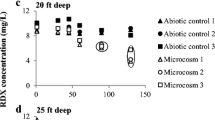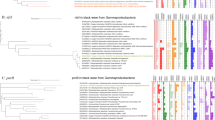Abstract
To investigate the important supportive microorganisms responsible for trichloroethene (TCE) bioremediation under specific environmental conditions and their relationship with Dehalococcoides (Dhc), four stable and robust enrichment cultures were generated using contaminated groundwater. Enrichments were maintained under four different conditions exploring two parameters: high and low TCE amendments (resulting in inhibited and uninhibited methanogenic activity, respectively) and with and without vitamin B12 amendment. Lactate was supplied as the electron donor. All enrichments were capable of reductively dechlorinating TCE to vinyl chloride and ethene. The dechlorination rate and ethene generation were higher, and the proportion of electrons used for dechlorination increased when methanogenesis was inhibited. Biologically significant cobalamin biosynthesis was detected in the enrichments without B12 amendment. Comparative genomics using a genus-wide microarray revealed a Dhc genome similar to that of strain 195 in all enrichments, a strain that lacks the major upstream corrin ring biosynthesis pathway. Seven other bacterial operational taxonomic units (OTUs) were detected using clone libraries. OTUs closest to Pelosinus, Dendrosporobacter, and Sporotalea (PDS) were most dominant. The Clostridium-like OTU was most affected by B12 amendment and active methanogenesis. Principal component analysis revealed that active methanogenesis, rather than vitamin B12 limitation, exerted a greater effect on the community structures even though methanogens did not seem to play an essential role in providing corrinoids to Dhc. In contrast, acetogenic bacteria that were abundant in the enrichments, such as PDS and Clostridium sp., may be potential corrinoid providers for Dhc.




Similar content being viewed by others
References
Brisson VL, West KA, Lee PKH, Tringe SG, Brodie EL, Alvarez-Cohen L (2012) Metagenomic analysis of a stable trichloroethene-degrading microbial community. ISME J 6:1702–1714
Chen M, Wolin MJ (1981) Influence of heme and vitamin B12 on growth and fermentations of Bacteroides species. J Bacteriol 145:466–471
Croft MT, Lawrence AD, Raux-Deery E, Warren MJ, Smith AG (2005) Algae acquire vitamin B12 through a symbiotic relationship with bacteria. Nature 438:90–93
Cupples AM, Spormann AM, McCarty PL (2003) Growth of a Dehalococcoides-like microorganism on vinyl chloride and cis-dichloroethene as electron acceptors as determined by competitive PCR. Appl Environ Microbiol 69:953–959
Cupples AM, Spormann AM, McCarty PL (2004) Comparative evaluation of chloroethene dechlorination to ethene by Dehalococcoides-like microorganisms. Environ Sci Technol 38:4768–4774
Daprato RC, Löffler FE, Hughes JB (2007) Comparative analysis of three tetrachloroethene to ethene halorespiring consortia suggests functional redundancy. Environ Sci Technol 41:2261–2269
Distefano TD, Gossett JM, Zinder SH (1992) Hydrogen as an electron donor for dechlorination of tetrachloroethene by an anaerobic mixed culture. Appl Environ Microbiol 58:3622–3629
Doherty RE (2000) A history of the production and use of carbon tetrachloride, tetrachloroethylene, trichloroethylene and 1,1,1-trichloroethane in the United States: part 1—historical background; carbon tetrachloride and tetrachloroethylene. Environ Forensics 1:69–81
Duhamel M, Edwards EA (2006) Microbial composition of chlorinated ethene-degrading cultures dominated by Dehalococcoides. FEMS Microbiol Ecol 58:538–549
Duhamel M, Mo K, Edwards EA (2004) Characterization of a highly enriched Dehalococcoides-containing culture that grows on vinyl chloride and trichloroethene. Appl Environ Microbiol 70:5538–5545
Freeborn RA, West KA, Bhupathiraju VK, Chauhan S, Rahm BG, Richardson RE, Alvarez-Cohen L (2005) Phylogenetic analysis of TCE-dechlorinating consortia enriched on a variety of electron donors. Environ Sci Technol 39:8358–8368
Futamata H, Yoshida N, Kurogi T, Kaiya S, Hiraishi A (2007) Reductive dechlorination of chloroethenes by Dehalococcoides-containing cultures enriched from a polychlorinated-dioxin-contaminated microcosm. ISME J 1:471–479
Gray MJ, Escalante-Semerena JC (2009) In vivo analysis of cobinamide salvaging in Rhodobacter sphaeroides strain 2.4.1. J Bacteriol 191:3842–3851
Gu AZ, Hedlund BP, Staley JT, Strand SE, Stensel HD (2004) Analysis and comparison of the microbial community structures of two enrichment cultures capable of reductively dechlorinating TCE and cis-DCE. Environ Microbiol 6:45–54
Guimaraes DH, Weber A, Klaiber I, Vogler B, Renz P (1994) Guanylcobamide and hypoxanthylcobamide—corrinoids formed by Desulfovibrio vulgaris. Arch Microbiol 162:272–276
He J, Sung Y, Krajmalnik-Brown R, Ritalahti KM, Löffler FE (2005) Isolation and characterization of Dehalococcoides sp strain FL2, a trichloroethene (TCE)- and 1,2-dichloroethene-respiring anaerobe. Environ Microbiol 7:1442–1450
He JZ, Holmes VF, Lee PKH, Alvarez-Cohen L (2007) Influence of vitamin B12 and cocultures on the growth of Dehalococcoides isolates in defined medium. Appl Environ Microbiol 73:2847–2853
He JZ, Ritalahti KM, Aiello MR, Löffler FE (2003a) Complete detoxification of vinyl chloride by an anaerobic enrichment culture and identification of the reductively dechlorinating population as a Dehalococcoides species. Appl Environ Microbiol 69:996–1003
He JZ, Ritalahti KM, Yang KL, Koenigsberg SS, Löffler FE (2003b) Detoxification of vinyl chloride to ethene coupled to growth of an anaerobic bacterium. Nature 424:62–65
Hendrickson ER, Payne JA, Young RM, Starr MG, Perry MP, Fahnestock S, Ellis DE, Ebersole RC (2002) Molecular analysis of Dehalococcoides 16S ribosomal DNA from chloroethene-contaminated sites throughout north America and Europe. Appl Environ Microbiol 68:485–495
Holmes VF, He JZ, Lee PKH, Alvarez-Cohen L (2006) Discrimination of multiple Dehalococcoides strains in a trichloroethene enrichment by quantification of their reductive dehalogenase genes. Appl Environ Microbiol 72:5877–5883
Janssen PH (1991) Isolation of Clostridium propionicum strain 19acry3 and further characteristics of the species. Arch Microbiol 155:566–571
Johnson DR, Brodie EL, Hubbard AE, Andersen GL, Zinder SH, Alvarez-Cohen L (2008) Temporal transcriptomic microarray analysis of “Dehalococcoides ethenogenes” strain 195 during the transition into stationary phase. Appl Environ Microbiol 74:2864–2872
Lee PKH, Cheng D, Hu P, West KA, Dick GJ, Brodie EL, Andersen GL, Zinder SH, He JZ, Alvarez-Cohen L (2011) Comparative genomics of two newly isolated Dehalococcoides strains and an enrichment using a genus microarray. ISME J 5:1014–1024
Lee PKH, Johnson DR, Holmes VF, He JZ, Alvarez-Cohen L (2006) Reductive dehalogenase gene expression as a biomarker for physiological activity of Dehalococcoides spp. Appl Environ Microbiol 72:6161–6168
Löffler FE, Ritalahti KM, Tiedje JM (1997) Dechlorination of chloroethenes is inhibited by 2-bromoethanesulfonate in the absence of methanogens. Appl Environ Microbiol 63:4982–4985
Maymó-Gatell X, Chien YT, Gossett JM, Zinder SH (1997) Isolation of a bacterium that reductively dechlorinates tetrachloroethene to ethene. Science 276:1568–1571
McCarty PL (1997) Microbiology: breathing with chlorinated solvents. Science 276:1521–1522
McMurdie PJ, Behrens SF, Müller JA, Goke J, Ritalahti KM, Wagner R, Goltsman E, Lapidus A, Holmes S, Löffler FE, Spormann AM (2009) Localized plasticity in the streamlined genomes of vinyl chloride respiring Dehalococcoides. PLoS Genet 5:e1000714
Men Y, Feil H, VerBerkmoes NC, Shah MB, Johnson DR, Lee PKH, West KA, Zinder SH, Andersen GL, Alvarez-Cohen L (2012) Sustainable syntrophic growth of Dehalococcoides ethenogenes strain 195 with Desulfovibrio vulgaris Hildenborough and Methanobacterium congolense: global transcriptomic and proteomic analyses. ISME J 6:410–421
Moe WM, Stebbing RE, Rao JU, Bowman KS, Nobre MF, da Costa MS, Rainey FA (2012) Pelosinus defluvii sp. nov., isolated from chlorinated solvent contaminated groundwater, emended description of the genus Pelosinus, and transfer of Sporotalea propionica to Pelosinus propionicus comb. nov. IJSEM 62:1369–1376
Moran MJ, Zogorski JS, Squillace PJ (2007) Chlorinated solvents in groundwater of the United States. Environ Sci Technol 41:74–81
Mosher JJ, Phelps TJ, Podar M, Hurt RA, Campbell JH, Drake MM, Moberly JG, Schadt CW, Brown SD, Hazen TC, Arkin AP, Palumbo AV, Faybishenko BA, Elias DA (2012) Microbial community succession during lactate amendment and electron-acceptor limitation reveals a predominance of metal-reducing Pelosinus spp. Appl Environ Microbiol 78:2082–2091
Ray AE, Bargar JR, Sivaswamy V, Dohnalkova AC, Fujita Y, Peyton BM, Magnuson TS (2011) Evidence for multiple modes of uranium immobilization by an anaerobic bacterium. Geochim Cosmochim Acta 75:2684–2695
Ray AE, Connon SA, Sheridan PP, Gilbreath J, Shields M, Newby DT, Fujita Y, Magnuson TS (2010) Intragenomic heterogeneity of the 16S rRNA gene in strain UFO1 caused by a 100-bp insertion in helix 6. FEMS Microbiol Ecol 72:343–353
Renz P (1999) Biosynthesis of the 5,6-dimethylbenzimidazole moiety of cobalamin and of the other bases found in natural corrinoids. In: Banerjee R (ed) Chemistry and biochemistry of B12. Wiley, New York, pp 557–575
Richardson RE, Bhupathiraju VK, Song DL, Goulet TA, Alvarez-Cohen L (2002) Phylogenetic characterization of microbial communities that reductively dechlorinate TCE based upon a combination of molecular techniques. Environ Sci Technol 36:2652–2662
Ritalahti KM, Löffler FE (2004) Populations implicated in anaerobic reductive dechlorination of 1,2-dichloropropane in highly enriched bacterial communities. Appl Environ Microbiol 70:4088–4095
Rowe AR, Lazar BJ, Morris RM, Richardson RE (2008) Characterization of the community structure of a dechlorinating mixed culture and comparisons of gene expression in planktonic and biofloc-associated “Dehalococcoides” and Methanospirillum species. Appl Environ Microbiol 74:6709–6719
Seshadri R, Adrian L, Fouts DE, Eisen JA, Phillippy AM, Methe BA, Ward NL, Nelson WC, Deboy RT, Khouri HM, Kolonay JF, Dodson RJ, Daugherty SC, Brinkac LM, Sullivan SA, Madupu R, Nelson KT, Kang KH, Impraim M, Tran K, Robinson JM, Forberger HA, Fraser CM, Zinder SH, Heidelberg JF (2005) Genome sequence of the PCE-dechlorinating bacterium Dehalococcoides ethenogenes. Science 307:105–108
Shelobolina ES, Nevin KP, Blakeney-Hayward JD, Johnsen CV, Plaia TW, Krader P, Woodard T, Holmes DE, VanPraagh CG, Lovley DR (2007) Geobacter pickeringii sp nov., Geobacter argillaceus sp nov and Pelosinus fermentans gen. nov., sp nov., isolated from subsurface kaolin lenses. IJSEM 57:126–135
Sieber JR, Sims DR, Han C, Kim E, Lykidis A, Lapidus AL, McDonnald E, Rohlin L, Culley DE, Gunsalus R, McInerney MJ (2010) The genome of Syntrophomonas wolfei: new insights into syntrophic metabolism and biohydrogen production. Environ Microbiol 12:2289–2301
Siebert A, Neumann A, Schubert T, Diekert G (2002) A non-dechlorinating strain of Dehalospirillum multivorans: evidence for a key role of the corrinoid cofactor in the synthesis of an active tetrachloroethene dehalogenase. Arch Microbiol 178:443–449
Strömpl C, Tindall BJ, Lunsdorf H, Wong TY, Moore ERB, Hippe H (2000) Reclassification of Clostridium quercicolum as Dendrosporobacter quercicolus gen. nov., comb. nov. IJSEM 50:101–106
Stupperich E, Eisinger HJ, Krautler B (1988) Diversity of corrinoids in acetogenic bacteria P-cresolylcobamide from Sporomusa ovata, 5-methoxy-6-methylbenzimidazolylcobamide from Clostridium formicoaceticum and vitamin B12 from Acetobacterium woodii. Eur J Biochem 172:459–464
Stupperich E, Steiner I, Ruhlemann M (1986) Isolation and analysis of bacterial cobamides by high-performance liquid-chromatography. Anal Biochem 155:365–370
Sung Y, Ritalahti KM, Apkarian RP, Löffler FE (2006) Quantitative PCR confirms purity of strain GT, a novel trichloroethene-to-ethene-respiring Dehalococcoides isolate. Appl Environ Microbiol 72:1980–1987
Walker CB, He ZL, Yang ZK, Ringbauer JA, He Q, Zhou JH, Voordouw G, Wall JD, Arkin AP, Hazen TC, Stolyar S, Stahl DA (2009) The electron transfer system of syntrophically grown Desulfovibrio vulgaris. J Bacteriol 191:5793–5801
West KA, Johnson DR, Hu P, DeSantis TZ, Brodie EL, Lee PKH, Feil H, Andersen GL, Zinder SH, Alvarez-Cohen L (2008) Comparative genomics of “Dehalococcoides ethenogenes” 195 and an enrichment culture containing unsequenced “Dehalococcoides” strains. Appl Environ Microbiol 74:3533–3540
Wolin EA, Wolin MJ, Wolfe RS (1963) Formation of methane by bacterial extracts. J Biol Chem 238:2882–2886
Wu CW, Whang LM, Cheng HH, Chan KC (2012) Fermentative biohydrogen production from lactate and acetate. Bioresour Technol 113:30–36
Yang YR, McCarty PL (1998) Competition for hydrogen within a chlorinated solvent dehalogenating anaerobic mixed culture. Environ Sci Technol 32:3591–3597
Yi S, Seth EC, Men YJ, Allen RH, Alvarez-Cohen L, Taga ME (2012) Versatility in corrinoid salvaging and remodeling pathways supports the corrinoid-dependent metabolism of Dehalococcoides mccartyi. Appl Environ Microbiol 78:7745–7752
Yu ZT, Smith GB (2000) Inhibition of methanogenesis by C1- and C2-polychlorinated aliphatic hydrocarbons. Environ Toxicol Chem 19:2212–2217
Acknowledgments
This research was supported by the Strategic Environmental Research and Development Program through grant ER-1587 and the National Institute of Environmental Health Sciences Superfund P42ES004705. We would like to give our thanks to Dr. Gary Andersen for microarray development, to Vanessa Brisson for the primer design of up-stream corrin ring biosynthesis genes, and to Ben Stenuit for the thoughtful discussion.
Author information
Authors and Affiliations
Corresponding author
Electronic supplementary material
Below is the link to the electronic supplementary material.
ESM 1
(PDF 364 kb)
Rights and permissions
About this article
Cite this article
Men, Y., Lee, P.K.H., Harding, K.C. et al. Characterization of four TCE-dechlorinating microbial enrichments grown with different cobalamin stress and methanogenic conditions. Appl Microbiol Biotechnol 97, 6439–6450 (2013). https://doi.org/10.1007/s00253-013-4896-8
Received:
Revised:
Accepted:
Published:
Issue Date:
DOI: https://doi.org/10.1007/s00253-013-4896-8




